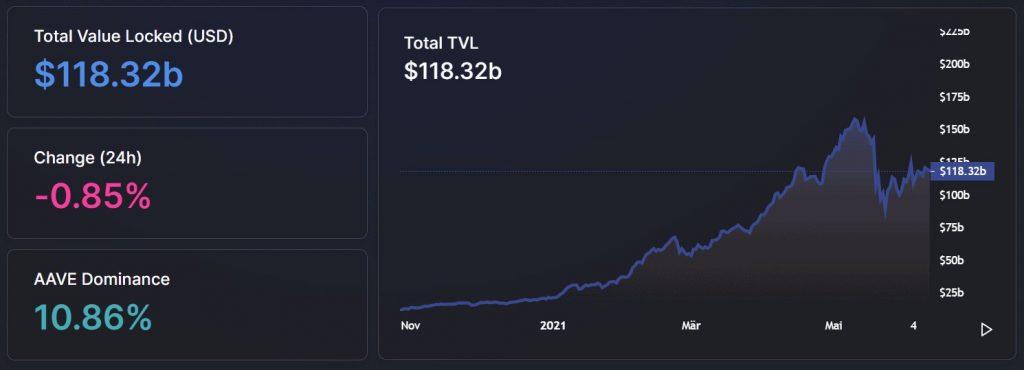The first regulatory approaches could meanwhile prepare the next wave of adoption.
It has been a month since the crypto market crash, but the aftereffects are still widely visible. The ten largest DeFi-Coins by market capitalisation are struggling on a weekly basis with some significant losses in the double-digit percentage range. The range extends from a 14 percent discount at Maker (MKR) to almost 30 percent at Chainlink (LINK). A recovery looks different, at least at the price level.
Because through the macro glasses, the situation looks a little more relaxed. The Total Value Locked (TVL), i.e. the entire assets managed by DeFi protocols, has increased by almost ten percent compared to the previous week. A good 40 billion US dollars are still missing before the record mark. After all, the TVL has made up $ 30 billion since the low three weeks ago. With currently almost 120 billion US dollars, the TVL is again at a strong level.


WEF designs DeFi toolkit
At the regulatory level, the first signs of the course for the still hesitant DeFi adoption are becoming apparent. The World Economic Forum (WEF) published a DeFi toolkit this week, which is intended to assist political decision-makers in risk-opportunity assessment and regulatory measures.
The white paper , in which the Wharton School of the University of Pennsylvania was also involved, does not make any concrete suggestions . Rather, it illuminates the opportunities, but also the dangers of decentralised finance. The toolkit therefore serves more as food for thought for authorities to face the open questions of the DeFi ecosystem and to formulate sensible regulatory solutions.
The toolkit has already found its first customer. Yehudi Castro Sierra, a consultant for digital transformation in Colombia, declared that his country would be the first one that wants to use the toolkit to develop policies and regulations around DeFi in Latin America.
Will DeFi manage self-regulation?
The Swiss venture capitalist Blockchain Valley Ventures (BVV) also confirms that regulation is becoming increasingly important in a current DeFi status quo report , especially when it comes to connecting institutional investors. Regulation is “a key challenge as DeFi is not really on the radar of regulators,” the report said. Initial concepts, however, indicated increased protection for investors. Interestingly, the report focuses less on political and more on technical regulation, i.e. the programming of secure smart contracts.
Also Read:
- China: Bitcoin mining is also banned in Xinjiang
- The Real Reasons behind the Latin American Bitcoin Revolution
- Facebook’s stablecoin Diem subordinates itself to CBDC
Ripple introduces sidechains
Ripple is also looking to join forces with the DeFi market . So far, the XRP Ledger has not supported any smart contracts. But that should change via sidechains, as chief developer David Schwartz announced. In the future, developers should be able to use a federator to create sidechains and connect them to the main ledger. In this way, different tokens can also be sent between blockchain networks.
The programming should be easy to use. In addition, developers can create their own protocol rules. For example, sidechains could be designed in which there are no transaction fees.

